Coal field - Tanden (English spelling)

|
A coalfield is an area that has a large amount of coal that can be mined profitably with the current level of mining technology. Coal is formed when the remains of trees are piled up in a certain area, covered with sediment, and buried, and then over many years they are subjected to pressure from sediment and rocks, as well as heat from geological disturbances such as mountain building. This process is called "coalification." Depending on the degree of "coalification," the coal changes into "brown coal," "subbituminous coal," "bituminous coal," and "anthracite." According to the World Energy Council's estimates of the world's reserves of bituminous coal, anthracite, subbituminous coal, and lignite, as well as the amount that can be mined taking into account technology and economics, the world has approximately 7 trillion tons of reserves, but it is known that 14% of this, or about 980 billion tons, can be mined. The method of calculating the reserves of a coalfield is as follows. That is, the amount of coal in the area adjacent to the current mining area and where the presence of coal has been confirmed within the area enclosed by two sides of the coal seam, the amount of coal in the area where the presence of coal seam has been confirmed by outcrops (the area where the coal seam is exposed on the ground surface, which is the best way to explore the coal seam on the ground surface), tunnels, borings, etc. and where mining is planned, and the amount of coal in the area where the coal seam confirmation degree is as described above and where mining is planned in the future, are added together to form the "confirmed amount of coal". Next, the amount of coal in the area where the presence of coal seam is considered to exist based on the geological conditions, etc., within the current mining depth, and the amount of coal in the area under the same geological conditions within the future mining depth, are added together to form the "estimated amount of coal". In contrast, the amount of coal in the area where the presence of coal seam can be determined based on the geological structure and the results of borings and physical exploration, etc., and where future mining is planned, is called the "projected amount of coal". In Japan, the coal seam that can be counted as the estimated amount is limited to one that is at least one meter thick and is within 1,200 meters from the surface. The sum of the three coal amounts, confirmed, estimated, and estimated, is the "theoretical coal reserves," but even if it is the theoretical coal reserves, it is not necessarily possible to mine the entire amount. There are parts that cannot be mined due to surface conditions and geological structures. The amount that is considered to be minable, excluding this amount, is called the "safe coal amount." However, when the safe coal amount is actually mined, there is some coal that is left unmined due to conditions inside the mine and safety reasons, so the actual production amount is less than the safe coal amount, and this is called the "actual coal amount." On the other hand, from an economic point of view, the amount of coal that is considered to be profitable is also called the "economic coal amount," and an even smaller amount than the actual coal amount is sometimes calculated. As mentioned above, the world's theoretically recoverable coal reserves are enormous, but Russia and the United States account for about 80% of the world's total. Russia, in particular, is said to have theoretical reserves of about 4 trillion tons. [Toshiro Isobe] Major coalfields of the worldThe most reliable source for the world's major coalfields is data from the International Energy Agency (IEA). Although the classification of coalfields varies slightly from country to country, countries with large amounts of coal, from anthracite to lignite, include Russia, the United States, China, Australia, Poland, South Africa, Germany, India, and the United Kingdom. [Toshiro Isobe] Japan's coalfieldsAccording to a 1998 World Energy Council document, Japan's theoretically recoverable coal reserves are 8.277 billion tons, of which 785 million tons are calculated to be minable. Coal is distributed throughout the country, but the only coalfields that can be called coalfields are the three coalfields of Ishikari in the center of Hokkaido, Kushiro in the east, and Tenpoku in the northernmost Wakkanai region; the Joban coalfield that straddles Fukushima and Ibaraki prefectures in Honshu, the Ube coalfield on the Seto Inland Sea in the Ube region of Yamaguchi prefecture, and the Omine coalfield in the center of the same prefecture; and the three coalfields of Chikuho, Munakata, and Fukuoka in the north of Fukuoka prefecture, and the Miike coalfield in the south of the prefecture, which extends into Saga prefecture. The most famous coalfields are the Karatsu and Sasebo coalfields, which straddle Nagasaki and Saga prefectures, and the Sakito Matsushima and Takashima coalfields, which lie on the seabed between the Goto Islands and the Nishisonogi Peninsula in Nagasaki prefecture. These two undersea coalfields are one, and are considered to be the largest undersea coalfield in Japan, with high-quality coking coal reserves, and are also known as the "Nishisonogi coalfield." However, due to the depletion of coal and the deterioration of coal quality, and even in places where good quality coal was produced, mines closed one after another due to pressure from cheap imported coal from overseas, and all major coal mines disappeared after the closure of Pacific Coal Mine (Kushiro) in 2002 (Heisei 14). It is highly likely that Japan will no longer be a coal-producing country in the future, but it can be said that it still has coalfields. However, this means that the amount of economic coal will be zero. [Toshiro Isobe] [Reference] | |Source: Shogakukan Encyclopedia Nipponica About Encyclopedia Nipponica Information | Legend |
|
現代の採掘技術のレベルで採算があって採掘のできる炭量が豊富に埋蔵されている区域を炭田という。石炭は、樹木の遺骸(いがい)が、ある地区に堆積(たいせき)し土砂をかぶって埋没したあと、長年月の間に土砂・岩石等の圧力および地熱、造山運動等の地質的擾乱(じょうらん)の際に生ずる熱作用を受けて、できたものである。このことを「石炭化作用」という。そして「石炭化」の程度によって「褐炭」「亜瀝青(あれきせい)炭」「瀝青炭」および「無煙炭」と変化していく。1998年世界エネルギー会議で推測された、全世界の瀝青炭・無煙炭と亜瀝青炭・褐炭の埋蔵量および技術力と経済性を考慮した採掘可能量によると、全世界では約7兆トンの埋蔵量はあるが、その14%の約9800億トンが採掘できることがわかっている。 炭田の埋蔵量の計算方法は次のようにして行う。すなわち、現採掘区域に隣接し、炭層内の二面で囲んだ範囲内に石炭の存在が確認されている部内の炭量、露頭(炭層が地表に露出している部分をいい、地表で炭層を探査するには最良の決め手となる)・坑道・ボーリング等で炭層の存在が認められていて、かつ採掘が計画されている区域の炭量、さらにこれに加えて、炭層確認度は上記のとおりで、将来採掘を予定している区域に存在する炭量等を合算して「確定炭量」という。次に、現採掘深度内にあり、地質条件等からみて炭層の存在が考えられる部内の炭量に、将来の採掘深度内でも同じ地質条件下にある部分の炭量等を合算して「推定炭量」という。これに対して、地質構造およびボーリング・物理探査等の結果を総合して、炭層があると判定でき、将来採掘が予定できる区域での炭量を「予想炭量」という。なお、予想炭量として算入できるには、日本では炭層の厚さが1メートル以上、炭層の深さは地表から1200メートル以内のものに限っている。以上、確定、推定および予想の三つの炭量の合計が「理論可採埋蔵炭量」であるが、理論可採埋蔵炭量といえども、全量は採掘できるとは限らない。地表条件、地質構造等で採掘不能の部分がある。この炭量を除き、採掘可能と考えられる量を「安全炭量」という。しかし、安全炭量も実際に採掘してみると、坑内条件、保安上の理由等々で、採掘されずに取り残されてしまう炭量が生ずるため、実質上の生産量は安全炭量より少なく、これを「実収炭量」といっている。また一方では、経済的見地から、採算性の考えられる炭量を「経済炭量」ともいい、実収炭量よりさらに少ない量を計算することもある。 以上のように、世界の理論可採埋蔵炭量は莫大(ばくだい)な量ではあるが、うちロシア、アメリカが世界全体の約80%を占めている。なかでも、ロシアは約4兆トンの理論埋蔵量があるといわれている。 [磯部俊郎] 世界のおもな炭田世界の主要炭田についてはIEA(国際エネルギー機関)の資料がもっとも信頼できる。炭田の分類等は国により多少異なるが、無煙炭から褐炭まで含めて、多量な石炭を有する国々はロシア、アメリカ、中国、オーストラリア、ポーランド、南アフリカ共和国、ドイツ、インド、イギリスなどである。 [磯部俊郎] 日本の炭田1998年世界エネルギー会議資料によれば、わが国の理論可採埋蔵炭量は82億7700万トン、うち7億8500万トンが採掘可能と算出されている。石炭は全国的に分布はしているが、炭田といいうるものは、北海道では、中央部の石狩(いしかり)、東部の釧路(くしろ)、最北端の稚内(わっかない)地方にある天北(てんぽく)の3炭田、本州では、福島・茨城県にまたがる常磐(じょうばん)、山口県宇部(うべ)地方の瀬戸内海海底の宇部、同県中央部の大嶺(おおみね)炭田があげられ、九州では、福岡県北部の筑豊(ちくほう)、宗像(むなかた)、福岡の3炭田、同県南部には佐賀県にも及んでいる三池(みいけ)炭田がある。長崎・佐賀両県にまたがる唐津(からつ)、佐世保(させぼ)炭田および長崎県の五島(ごとう)列島と西彼杵(にしそのぎ)半島間の海底にある崎戸(さきと)松島および高島炭田が有名である。両海底炭田は一つのもので、良質原料炭が埋蔵されているわが国最大の海底炭田と考えられ、「西彼杵炭田」ともいわれている。 しかし炭量枯渇や炭質劣化により、また良質炭を産出したところでも安価な海外からの輸入炭に押され鉱山の閉山が相次ぎ、2002年(平成14)の太平洋炭礦(釧路)閉山を最後に大手炭鉱はすべて姿を消した。今後日本は産炭国ではなくなる可能性が大きいが、炭田は保有していると考えてよい。ただし経済炭量はゼロということになる。 [磯部俊郎] [参照項目] | |出典 小学館 日本大百科全書(ニッポニカ)日本大百科全書(ニッポニカ)について 情報 | 凡例 |
Recommend
Positive image
〘 noun 〙 A photograph in which the hues and light ...
The Ervand Dynasty - Ervandcho
…the historical name of the region centered on th...
Hidden Area - Kakushichi
…Manorial lords aimed to secure financial resourc...
Calcium hydroxide - Suisankasuumu (English spelling) calcium hydroxide
A hydroxide of calcium. Also known as slaked lime...
"Kanhasshu Kosenroku" - Kanhasshu Kosenroku
...In 1590 (Tensho 18), when Toyotomi Hideyoshi a...
Trade Statistics of Japan
Based on the provisions of the Customs Law, stati...
Law of chemical equilibrium
For the chemical reaction a A + b B + …⇄ p P + q ...
Radiation therapy
Also called radiation therapy. A treatment method ...
Korean Socialist Party
...He later fled to Manchuria and Siberia, where ...
Nayoro
The word nayoroshi means a list of names, and is ...
Masumi
...the main political party representing Islam in...
Weather by month / year - Uonzu
A composite graph showing monthly changes in preci...
Factorization
When a polynomial is equal to the product of two ...
baptism
… The Church first included the seven numbers of ...
Mirounga angustirostris (English spelling) Miroungaangustirostris
… Seal [Yasuhiko Naito]. . . *Some of the termino...









![Chiryu [city] - Chiryu](/upload/images/67cc38ac745a5.webp)